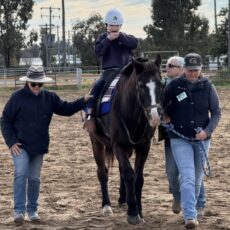The award winning short documentary The Kamilaroi will be broadcast on National Indigenous Television on Friday, January 17 at 7pm.
The NITV documentary tells the Dreamtime stories and cultural traditions of traditional owners, the Kamilaroi.
The documentary was produced by Boggabri Coal.
“It’s important we show our appreciation and respect for the Kamilaroi and their special connection with the land,” general manager of Boggabri Coal Anthony Margetts said.
“We’re proud to have contributed to the making of this documentary and we hope it serves as an educational resource that can be used by all Australians to improve their cultural awareness and understanding of the Kamilaroi Nation.” The film was made in partnership with the Kamilaroi and features members of the Kamilaroi Nation sharing their historic, cultural and spiritual stories.
Kamilaroi man Greg Griffiths said, it was important to record Kamilaroi cultural stories so they can be shared with the community and passed on to future generations.
“Aboriginal people have a strong storytelling tradition. Our stories are about who we are and it’s how we pass on our traditions and our culture. This documentary is an excellent way for us to do that,” said Mr Griffiths.
“Kamilaroi people are a sharing culture and we want to share our stories with all Australians.
“Sharing stories is how we maintain connection to each other and to country and that’s very important for Aboriginal people” prominent Kamilaroi woman Dolly Talbot added.
“We are most grateful to the Kamilaroi members for participating in the film and for their generosity in sharing these stories,” executive producer of the documentary Hamish Russell said.
“The response so far to the documentary from the community and from schools has been overwhelming.”
The Kamilaroi recently won a Community Excellence Award at the NSW Mining Conference HSEC Awards 2019.
Kamilaroi heritage and culture explored in television documentary
“One of Australia’s largest and most significant Aboriginal First Nations, the Kamilaroi peoples’ enduring connection with the land and their deep understanding of the natural environment is explored through the examination of important archaeological sites, the demonstration of cultural knowledge and the retelling of cultural stories” the documentary says.
“Each story is rich with cultural meaning, highlighting Kamilaroi knowledge, ingenuity, and sustainable living practices.
“The ‘Emu in the Sky’ story, centred around a great emu visible in the Milky Way, holds untold generations of cultural knowledge.
“Throughout their history the Kamiliaroi have read the night sky.
“The emu’s movement through the seasons help them determine the time of many natural events, including when emu eggs could and could not be harvested.
“Similarly, the inspection of an old ‘scar tree’, where a slab of bark has been removed to make a canoe, reveals innate knowledge about where the strongest bark could be taken without harming the tree.
“The sustainability theme is reinforced with the explanation of the Kamilaroi totemic social structure whereby individuals within tribal groups were assigned a relationship with and responsibility for specific animals such as emus or kangaroos. The Kamilaroi connection to country is highlighted by the sourcing of bush medicine from the quinine tree and the cooking of a yellow belly fish covered in mud over an open fire.
“That connection is lost when, in the case of a large ancient groove stone, (below) an important cultural artefact is removed from its original location and deposited on the edge of a town park.
“The documentary culminates in a visit to a well-known local landmark, controversially named Gin’s Leap. The conflicting stories about how Gin’s Leap acquired its name, and the derogatory nature of the label, underscore how history and identity have been appropriated and how far there is still to travel on the path to reconciliation.”
‘The Kamilaroi’ serves as an important tool for passing on Kamilaroi cultural knowledge for future generations and sharing it with a broad Australian audience.
“At a time of heightened debate about Aboriginal constitutional recognition, the documentary finishes with a hopeful message that Aboriginal people can maintain connection with each other and to country.
“It also provides an important message about sustainability and embracing Aboriginal culture as an integral part of Australian cultural identity.”
‘Gin’s Leap’
“Gin’s Leap is a well-known landmark just outside Boggabri on the Kamilaroi Highway heading towards Narrabri” the documentary says.
“The derogatory nature of the label is contentious and there are conflicting stories about how Gin’s Leap acquired its name.
“The story that is generally told and documented on the signage is that a young Aboriginal woman was in love but was promised to another Aboriginal man.
She was then chased up to the top of the cliff by the tribe and, rather than being with a man she didn’t want to be with, chose to jump off the cliff to her death.
“However, as Dolly Talbott and ‘Polly’ Cutmore relate, this is considered a ‘whitewashed’ lover’s story by local Aboriginal people.
“The Aboriginal name for the location is ‘Coolabindi’ and the story told by the Kamilaroi is that a local squatter drove an Aboriginal woman off the cliff to her death.
“To add insult to injury, the name Gin’s Leap is particularly offensive because ‘Gin’ was a name given to Aboriginal women who were plied with alcohol so the white settlers could take advantage of them.”
The Boggabri groove stone
A large stone marked with several carvings sits in a Boggabri park.
“As Kamilaroi elder Mitchum Neave, above, explains, it is in fact an ancient grinding groove stone used for generations to sharpen tools and weapons” the documentary reveals.
“Mitchum demonstrates how the grinding grooves were used to sharpen an axe head and over time deepen the grooves.
“However, because the stone has been removed from its original location, Mitchum explains it has lost its spiritual connection to the land and that he no longer feels any connection to it.
“To retrieve its connection and be part of a greater storyline it needs to be returned to its original location.”
Waterloo Creek massacre
Raymond Weatherall relates the story of the 500 where the best warriors from the various Kamilaroi clans gathered to resist the first incursions of white settlers when Major Nunn and Sir Thomas Mitchell made their way into the area in the 1850s.
Much later, after the warriors dispersed there was an infamous massacre at Waterloo Creek and the survivors were sent to a reserve at Terry Hie Hie.
Raymond is a descendant of those who survived the massacre.
He explains that the story of the 500 is used as an inspirational story of how the Kamilaroi continue to stand up for their rights.
To order photos from this page click here










